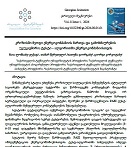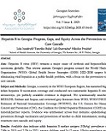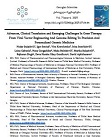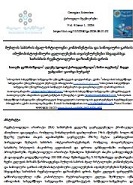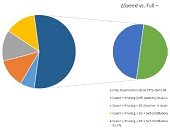Frequency of Vaginal Candida in Diabetes Patients – Overview
Downloads
Aim/objective: The aim of the article is to identify the frequency and prevalence of vaginal candida in diabetes patients. Background: Rising blood sugar levels in patients increase the risk of various diseases and increase health problems. Possible long-term effects include damage to the macrovascular and microvascular vessels, which can lead to vascular diseases, including heart attack, stroke, and problems with the kidneys, eyes, gums, legs, and nerves. In addition to vascular damage, diabetes causes bacterial and fungal infections, among which we often find infection caused by Candida. Fungal disease of the genitals is one of the most common pathologies today, the development of which can be facilitated by both external - exogenous and internal - endogenous factors. Design and Methods: The article is based on secondary research and is limited to descriptive analysis. Results and Conclusions: Increased blood sugar levels as a result of diabetes affect the whole body and not just the blood. Elevated blood sugar appears in the mucous membranes of the vagina and vulva, so they are an excellent means of cultivating yeast. Properly managed diabetes is the only correct way to prevent recurrent vulvovaginal candidiasis.
Downloads
Metrics
SG:pub.10.1186/1471-2334-2-1 - springer nature scigraph. Accessed February 15, 2022. https://scigraph.springernature.com/pub.10.1186/1471-2334-2-1.
Cosentino F;Grant PJ;Aboyans V;Bailey CJ;Ceriello A;Delgado V;Federici M;Filippatos G;Grobbee DE;Hansen TB;Huikuri HV;Johansson I;Jüni P;Lettino M;Marx N;Mellbin LG;Östgren CJ;Rocca B;Roffi M;Sattar N;Seferović PM;Sousa-Uva M;Valensi P;Wheeler DC; ; “2019 ESC Guidelines on Diabetes, Pre-Diabetes, and Cardiovascular Diseases Developed in Collaboration with the EASD.” European heart journal. U.S. National Library of Medicine. Accessed February 15, 2022. https://pubmed.ncbi.nlm.nih.gov/31497854/
Kavanagh, Catherine, and Natalie S. Uy. “Nephrogenic Diabetes Insipidus.” Pediatric Clinics of North America 66, no. 1 (2019): 227–34. https://doi.org/10.1016/j.pcl.2018.09.006.
“კანდიდოზი.” კანდიდოზი. Accessed February 15, 2022. http://urologi.ge/health/infeqciebi/kandidozi
Buse JB;Wexler DJ;Tsapas A;Rossing P;Mingrone G;Mathieu C;D'Alessio DA;Davies MJ; “2019 Update to: Management of Hyperglycemia in Type 2 Diabetes, 2018. A Consensus Report by the American Diabetes Association (ADA) and the European Association for the Study of Diabetes (EASD).” Diabetes care. U.S. National Library of Medicine. Accessed February 15, 2022. https://pubmed.ncbi.nlm.nih.gov/31857443/.
“Essentials of Human Anatomy and Physiology 10th Edition.” Accessed February 15, 2022. http://wp.dinnertime.com/d/download/U6B2Z8/essentials-of-human-anatomy-and-physiology-10th-edition_pdf.
BS;, Atabek ME;Akyürek N;Eklioglu. “Frequency of Vagınal Candida Colonization and Relationship between Metabolic Parameters in Children with Type 1 Diabetes Mellitus.” Journal of pediatric and adolescent gynecology. U.S. National Library of Medicine. Accessed February 15, 2022. https://pubmed.ncbi.nlm.nih.gov/24012126/.
Gunther LS;Martins HP;Gimenes F;Abreu AL;Consolaro ME;Svidzinski TI; “Prevalence of Candida Albicans and Non-Albicans Isolates from Vaginal Secretions: Comparative Evaluation of Colonization, Vaginal Candidiasis and Recurrent Vaginal Candidiasis in Diabetic and Non-Diabetic Women.” Sao Paulo medical journal = Revista paulista de medicina. U.S. National Library of Medicine. Accessed February 15, 2022. https://pubmed.ncbi.nlm.nih.gov/24714993/.
Pointer, Kathleen. “Diabetes and Yeast Infections: Is There a Link?” Healthline. Healthline Media, August 29, 2018. https://www.healthline.com/health/diabetes/diabetes-and-yeast-infections#diabetes-and-yeast-infections.
“Diabetes and Yeast Infections (Candidiasis): Risk, Symptoms, and More.” Medical News Today. MediLexicon International. Accessed February 15, 2022. https://www.medicalnewstoday.com/articles/317824#diabetes-yeast.
Vroomen-Durning, Marijke, Don Rauf, Kate Ruder, Maria Masters, Everyday Health Staff, Lauren Bedosky, Lisa Rapaport, and Becky Upham. “Type 2 Diabetes and Yeast Infections.” EverydayHealth.com. Accessed February 15, 2022. https://www.everydayhealth.com/type-2-diabetes/yeast-infections/
de Leon, Ella M, Scott J Jacober, Jack D Sobel, and Betsy Foxman. “Prevalence and Risk Factors for Vaginal Candida Colonization in Women with Type 1 and Type 2 Diabetes.” BMC infectious diseases. BioMed Central, 2002.
Taylor, Rebecca Buffum. “Diabetes Mellitus: Type 1, Type 2, and Gestational Diabetes.” WebMD. WebMD. Accessed February 16, 2022. https://www.webmd.com/diabetes/guide/types-of-diabetes-mellitus.
Garite, Thomas J., and Moon H. Kim. “The State of the American Journal of Obstetrics & Gynecology: 2009.” American Journal of Obstetrics and Gynecology 201, no. 1 (2009): https://doi.org/10.1016/j.ajog.2009.05.043.

This work is licensed under a Creative Commons Attribution-NonCommercial-NoDerivatives 4.0 International License.














